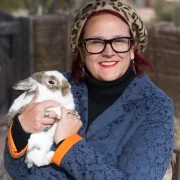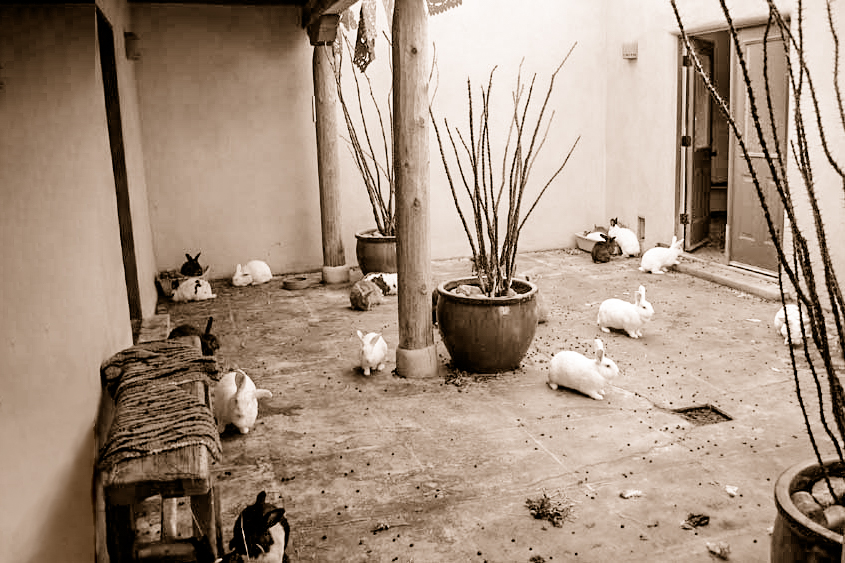From Chapter 2 of Stories Rabbits Tell: A Natural and Cultural History, by Susan Davis and Margo DeMello
Humans “kept” wild rabbits in groups, in wild rabbit gardens, for centuries before they began to experiment with characteristics like color, size and form. Once the process of domestication began, humans most likely began to keep rabbits apart, so they could more easily control the partners and timing involved in the breeding. Today, most accounts of domestic rabbit behavior are based on rabbits living alone as pets or as laboratory animals, or consorting in pairs during commercial breeding. As a result, most people don’t even realize that domestic rabbits are social creatures.
A handful of people across the country, however, have experimented with keeping relatively large groups of rabbits together, in warren-like situations. Such arrangements aren’t for everyone. Most laypeople have neither the space nor the time to keep up with a herd of rabbits. But for those who do, hosting a herd can yield valuable information on just how closely domestic rabbit behavior can mimic wild rabbit behavior.
In Margo’s home, the rabbits live pretty much free-range, although only a cherished few are allowed into her living room and kitchen. The rest of the rabbits sleep inside, in “rabbit rooms,” at night and spend the day going inside and outside as they please via a cat door. That means her rabbits don’t actually live in warrens or burrows; they make use of a built environment. But they’re allowed the freedom to go where they please and do what they like throughout the day.
Many of those activities match what rabbits might do in the wild. Although Margo discourages the digging of tunnels, the rabbits do have a variety of tubes and tunnels (primarily made of plastic and cardboard) in which to play, run and sleep. In addition, they have children’s play structures, supplemented by cat and rabbit playhouses that feature lots of tunnels, levels, overlooks and hidey-holes. This way the rabbits can sit on, under or inside of most of their structures, experiencing the security of “underground,” a variety of “rooms” for different activities and as elevated lookouts from which to survey their world.
Besides their very different physical environment, domestic rabbits living in groups also differ from their wild brethren in that they don’t have to compete for food, nor do they have to worry about reproduction. But other features of wild warren life—territorial behavior, social structure and non-reproductive mating—are still prominent features of domestic life.
Over the years, Margo’s warren has ranged in size from fifteen to sixty-five rabbits. As the individuals in the group have changed, the group dynamics have changed as well. But the basic social unit has always remained the couples and cliques, each with its own leader. In the past, there have been one or two dominant leaders who not only ruled their own clique, but the entire group as well. At other times, there seems to be no single leader. Instead, a handful of strong figures command respect from the others who circulate around them.
Elizabeth Marshall Thomas compares the social structures of dogs and cats, saying that the dogs’ structure is analogous to a ladder, with a single leader on top and all the subordinate dogs falling underneath the leader in a hierarchy. Cats, she claims, have a wheel-like structure, with the leader in the middle of the wheel and all the subordinates occupying the spokes around the perimeter. In this scenario, the lesser cats are all subordinate to the leader, yet equal to each other.[1] A rabbit hierarchy contains multiple, overlapping circles, with a leader in each, along with a number of unattached individuals who don’t fit with one group but come and go between the groups. The groups themselves are arranged hierarchically, with some groups—and their leader—dominating the others.
Margo’s rabbits pick territories (in the house and the yard) and fight to protect them. Needless to say, just as the “cool” tough kids in high school stake out the spot where they like to hang out, the most dominant cliques in a rabbit group pick the best territories and the lesser cliques stay away. In a previous house and yard, the redwood picnic table in the corner of the yard was taken over by the dominant group, led by Dairy Queen. All seven rabbits in her group (including the submissive Wormguy, who somehow found himself in the cool clique) spent their days on and around the table. In Margo’s current setup, one particular plastic play structure has become the focal point of the rabbit room, and Amelia or Praline gets to lie on it every night, sometimes with a friend. Others, like frail Trouble, wouldn’t even try to sit there.
Another feature of territorial behavior is “competitive peeing and pooping.” Like in the wild, domestic rabbits use urine and feces to mark the boundaries of their territory, and even litterbox-trained house rabbits are no different. When indoor rabbits live alone, or with one or two other rabbits, they are usually pretty good about their litter box habits. At Margo’s house, the pee and poop situation is a little harder to control, as all the rabbits are marking all the time to sort out the overlapping territories. Some of the rabbits even pee on newcomers (that’s new rabbits, not new humans) to mark them as territory, too.
In wild warrens, the “chief” rabbit is generally male. In domestic groups, the dominant rabbit is often female. In fact, the females are generally the more aggressive and territorial rabbits in Margo’s warren, which is odd, given the fact that they are all spayed and not protecting their burrows or their young. Dominance appears to be based on a number of factors. Generally a dominant rabbit must be fearless, outgoing and smart, and must have some history within the group. Size is not the only factor, although it sometimes helps. For instance, Amelia is one of the most dominant rabbits in Margo’s group—keeping most of the other rabbits in the large group under control, constantly slipping out of the main group to harass the angoras who live in the next room and demanding the first, best and largest servings of snacks. Yet Amelia is a small rabbit, a silver marten, who is dwarfed by almost all the other rabbits in Margo’s home.
Another small leader, from a few years back, was Ramona. Ramona was a hotot—a small white rabbit with black rings around her black eyes. She was the leader of a gang of five rabbits—Georgette, Big Bear, Potato and her number one man, Jake—and she tolerated very little slack from her obedient charges. She was aggressive and overly confident, and threw her (small) weight around, forcing the others in her group to do her dirty work for her. Ramona was like the girl in high school who wore jeans that were too tight, blouses cut way too low and a lot of mascara, and hung out with the smokers behind the school. Until Ramona died, no one messed with her or her friends.
New rabbits bear the brunt of the territorial behavior in a domestic group, just as they do in the wild, but luckily, over the years, Margo’s group as a whole has become more tolerant of newcomers. Interestingly, even as the individuals in the group have completely turned over in the twelve years since Margo has had a warren, the group itself has evolved, the result being that the transition time after a new rabbit is introduced has shortened from at least two weeks to much less than a week today. Because the aggression towards newcomers is milder and shorter-lived, the newcomers, in turn, appear to learn the group dynamics, daily structure and other important social facts in a much shorter time.
Konrad Lorenz and other animal behaviorists have long asserted that “animals have no culture.” But plenty of people who live with, work with and think about animals now believe that animals do have culture, if culture is defined as the transmission of behaviors from one generation to the next. According to primatologist Frans de Waal, “Culture simply means that knowledge and habits are acquired from others—often, but not always, from the older generation—which explains why two groups of the same species may behave differently.”[2] The classic example of these socially transmitted behaviors is found in the Japanese macaques’ tradition of washing potatoes, in which one macaque named Imo began, in the 1950s, carrying her dirty potatoes to the water to wash them; soon the others in her group started washing their potatoes. Even after all the original potato-washing macaques had died out, the band continued—and continue today—to wash their potatoes.
In rabbits, cultural transmission can be seen in examples as simple as Phoebe teaching Elmo to sleep under the bed, and Elmo sharing his new knowledge with Maybelline, who then passed it to Mr. Bop. Another example is the way that Puddles and Muddles, Margo’s two angoras, taught Puffy, and later, Helga, to sneak out of their room in search of a disabled rabbit with snacks to steal. But the transmission of culture can also be more abstract and complex—as evidenced by the fact that Margo’s large group of rabbits seems to have a group understanding that new rabbits will periodically enter and that, unlike ten years ago, there needn’t be a huge territorial battle each time this occurs.
Mealtimes and bedtimes have also become much more organized and less chaotic than in previous years. When Margo lived in a different house, with a group of thirty to forty rabbits, the rabbits slept in her garage but spent their daytime hours playing in the backyard. Because Margo had no easy access to the backyard, the rabbits had to travel every morning from the garage through the living room, around the corner in the hallway, into the bedroom, and up a ramp to her bedroom window, where they would then go down another ramp into their yard. Evenings the trek would be reversed, and three dozen rabbits would be asked to run up the outside ramp, down the inside ramp and back through the house to their beds and dinner. While the group ran outdoors in the morning without much fuss, getting them indoors at night often took an hour. As soon as Margo came out to begin the evening’s activities, the smartest and the hungriest rabbits would immediately run up the ramp and head inside (and some, like Baby, would be waiting at the top of the ramp for Margo to let her in!). But most of the group took much longer to climb up the ramp, and some, like Jerry, Jake and Ramona, actively evaded Margo for what seemed like hours every night. Sometimes they never did go up the ramp, and the only way Margo got them indoors was by catching them and forcing them through the window against their will.
Years later, the minute the rabbits in Margo’s current group hear her coming into their room (which thankfully has a cat door leading directly to their play yard) at dusk, the vast majority of them immediately race into their room for their dinner. Even newcomers like Angie, Bert and Ernie, who just arrived not more than a week ago, quickly learned the evening routine and come in with the others at dinnertime.
Even dinnertime etiquette has evolved. After the rabbits have gotten their fresh vegetables, Margo fills four to six bowls of pellets every evening and places them on the floor for the group to share. At first, the rabbits would clamor anxiously (and sometimes aggressively) for the bowls, fighting to get their heads into the first bowl placed on the ground. By the time Margo got the fourth or fifth bowl down, she usually had to push a few rabbits from the overcrowded bowls to eat out of the last bowls. Eventually, a couple of the smarter rabbits started to realize that if they simply waited till Margo put down the last bowls, they could save themselves the stress of fighting over the first bowls, and could instead eat at one of the last bowls, perhaps all by themselves. Finally, with time, all the rabbits seemed to realize there would always be enough food for all. Today, there is less jostling over the bowls, and the rabbits are more evenly dispersed throughout the room at dinner time.
One of the odd things about rabbits living out of cages or in groups is the reaction they get from people who have only met rabbits in cages. People who come to our houses are often stunned, for instance, to find two rabbits lying contentedly side by side (“They really love each other! That’s so cute!”) or to see a rabbit madly dashing through the dining room (“Oh, look! She’s in a hurry! That’s so cute!”) Some people are moved to inquire further—about whether the rabbits are affectionate; if they mate; if they really use the litter box. When we tell them the truth (yes, they’re affectionate; no, they don’t mate–they’re altered; and yes, they have excellent litter box habits), the guests look puzzled. If we tell a few anecdotes about the rabbits—how Mr. Bop flops over on his side when he hears the song Baby Beluga or how Maybelline sneaks up behind Susan and nips her socks to ask for a pat—they look at us like we’re nuts. Such antics would raise no eyebrows if the subjects were dogs or cats or horses, but because they’re about rabbits, our stories seem worthy of suspicion.
Oddly, even some people who raise rabbits don’t know about the full range—or roots—of rabbit behavior. In September 2002, a breeder of meat rabbits posted a question to a listserve dedicated to meat rabbits. He had been debating whether or not to let his rabbits run in an enclosed turkey coop. Another breeder noted that they would become “wild,” i.e., hard to catch and possibly vicious. “I want to be able to pick up my rabbits without getting torn apart,” the advisor wrote.[3] The original poster then replied:
I really like the idea of keeping the rabbits inside of an enclosure hence my idea about the turkey coop. I have raised rabbits quite some time ago and would let them out of their hutch into the goat yard while giving the hutch a good hosing down and allowing enough time to dry in the sun. Even after several hours of being out they displayed more wild behavior. I am glad you gave me a reminder of that![4]
That wild behavior, sadly, probably only meant grooming each other, popping binkies, running in circles, and playing games. If the rabbits evaded capture, well, perhaps they knew they were going to be put back in their cages—or worse. In safer environments, free range rabbits may be high-spirited, feisty, or indulgently lazy, but they don’t become dangerous “wild” animals. They become autonomous creatures who display as many moods, and preferences, and communication styles as more familiar, more beloved pets, like cats and dogs. They may not leap into laps or beg to play ball (although rabbits have been known to do both), but they interact with humans as effectively and profoundly and affectionately as their other pet brethren.
Footnotes
[1] Marshall Thomas, Elizabeth, The Tribe of Tiger (New York: Pocket Books, 1994), p. 71.
[2] Quoted In Friend, Tim, “Culture’s Not only Human,” In USA Today, June 5, 2001
[3] September 23, 2002
[4] Ibid.
-

Margo DeMello
Margo DeMello PhD is an anthrozoologist, animal activist, and writer. She is an Assistant Professor of Anthrozoology at Carroll College. For the past 15 years, she was the Human-Animal Studies Program Director at the Animals & Society Institute. She loves rabbits, chihuahuas, wombats and sloths. She is a knitter, a gardener, and a true crime fanatic.
View all posts -

Susan E. Davis
Award-winning journalist and editor Susan E. Davis has written for a wide range of publications, including Sports Illustrated, Mademoiselle, The Nation, and The Washington Post. She is the author of The Sporting Life and Baby Play.
View all posts
